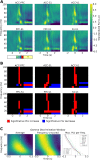Frequency-specific coupling in fronto-parieto-occipital cortical circuits underlie active tactile discrimination
- PMID: 30911025
- PMCID: PMC6434051
- DOI: 10.1038/s41598-019-41516-3
Frequency-specific coupling in fronto-parieto-occipital cortical circuits underlie active tactile discrimination
Abstract
Processing of tactile sensory information in rodents is critically dependent on the communication between the primary somatosensory cortex (S1) and higher-order integrative cortical areas. Here, we have simultaneously characterized single-unit activity and local field potential (LFP) dynamics in the S1, primary visual cortex (V1), anterior cingulate cortex (ACC), posterior parietal cortex (PPC), while freely moving rats performed an active tactile discrimination task. Simultaneous single unit recordings from all these cortical regions revealed statistically significant neuronal firing rate modulations during all task phases (anticipatory, discrimination, response, and reward). Meanwhile, phase analysis of pairwise LFP recordings revealed the occurrence of long-range synchronization across the sampled fronto-parieto-occipital cortical areas during tactile sampling. Causal analysis of the same pairwise recorded LFPs demonstrated the occurrence of complex dynamic interactions between cortical areas throughout the fronto-parietal-occipital loop. These interactions changed significantly between cortical regions as a function of frequencies (i.e. beta, theta and gamma) and according to the different phases of the behavioral task. Overall, these findings indicate that active tactile discrimination by rats is characterized by much more widespread and dynamic complex interactions within the fronto-parieto-occipital cortex than previously anticipated.
Conflict of interest statement
The authors declare no competing interests.
Figures






Similar articles
-
Tactile spatial attention enhances gamma-band activity in somatosensory cortex and reduces low-frequency activity in parieto-occipital areas.J Neurosci. 2006 Jan 11;26(2):490-501. doi: 10.1523/JNEUROSCI.5228-04.2006. J Neurosci. 2006. PMID: 16407546 Free PMC article.
-
Cortical and thalamic contributions to response dynamics across layers of the primary somatosensory cortex during tactile discrimination.J Neurophysiol. 2015 Sep;114(3):1652-76. doi: 10.1152/jn.00108.2015. Epub 2015 Jul 15. J Neurophysiol. 2015. PMID: 26180115 Free PMC article.
-
Neuronal Assemblies Evidence Distributed Interactions within a Tactile Discrimination Task in Rats.Front Neural Circuits. 2018 Jan 11;11:114. doi: 10.3389/fncir.2017.00114. eCollection 2017. Front Neural Circuits. 2018. PMID: 29375324 Free PMC article.
-
Mapping of architectonic subdivisions in the macaque monkey, with emphasis on parieto-occipital cortex.J Comp Neurol. 2000 Dec 4;428(1):79-111. doi: 10.1002/1096-9861(20001204)428:1<79::aid-cne7>3.0.co;2-q. J Comp Neurol. 2000. PMID: 11058226
-
The history of the neurophysiology and neurology of the parietal lobe.Handb Clin Neurol. 2018;151:3-30. doi: 10.1016/B978-0-444-63622-5.00001-2. Handb Clin Neurol. 2018. PMID: 29519464 Review.
Cited by
-
Neurophysiological correlates of tactile width discrimination in humans.Front Hum Neurosci. 2023 May 12;17:1155102. doi: 10.3389/fnhum.2023.1155102. eCollection 2023. Front Hum Neurosci. 2023. PMID: 37250697 Free PMC article.
-
LPS-induced acute neuroinflammation, involving interleukin-1 beta signaling, leads to proteomic, cellular, and network-level changes in the prefrontal cortex of mice.Brain Behav Immun Health. 2023 Jan 21;28:100594. doi: 10.1016/j.bbih.2023.100594. eCollection 2023 Mar. Brain Behav Immun Health. 2023. PMID: 36713475 Free PMC article.
-
Amphiregulin normalizes altered circuit connectivity for social dominance of the CRTC3 knockout mouse.Mol Psychiatry. 2023 Nov;28(11):4655-4665. doi: 10.1038/s41380-023-02258-x. Epub 2023 Sep 20. Mol Psychiatry. 2023. PMID: 37730843 Free PMC article.
-
Differential width discrimination task for active and passive tactile discrimination in humans.MethodsX. 2020 Mar 19;7:100852. doi: 10.1016/j.mex.2020.100852. eCollection 2020. MethodsX. 2020. PMID: 32309150 Free PMC article.
-
Cross-Talk of Low-Level Sensory and High-Level Cognitive Processing: Development, Mechanisms, and Relevance for Cross-Modal Abilities of the Brain.Front Neurorobot. 2020 Feb 14;14:7. doi: 10.3389/fnbot.2020.00007. eCollection 2020. Front Neurorobot. 2020. PMID: 32116637 Free PMC article. Review.
References
-
- Woolsey TA, Van Der Loos H. The structural organization of layer IV in the somatosensory region (SI) of mouse cerebral cortex. The description of a cortical field composed of discrete cytoarchitectonic units. Brain Res. 1970;17:205–242. - PubMed
-
- Welker C. Receptive fields of barrels in the somatosensory neocortex of the rat. J. Comp. Neurol. 1976;166:173–189. - PubMed
-
- Romanski, L. Convergence of Auditory, Visual, and Somatosensory Information in Ventral Prefrontal Cortex. in The Neural Bases of Multisensory Processes. (eds Murray, M. M. & Wallace, M. T.) (CRC Press/Taylor & Francis, 2012). - PubMed
Publication types
MeSH terms
LinkOut - more resources
Full Text Sources

